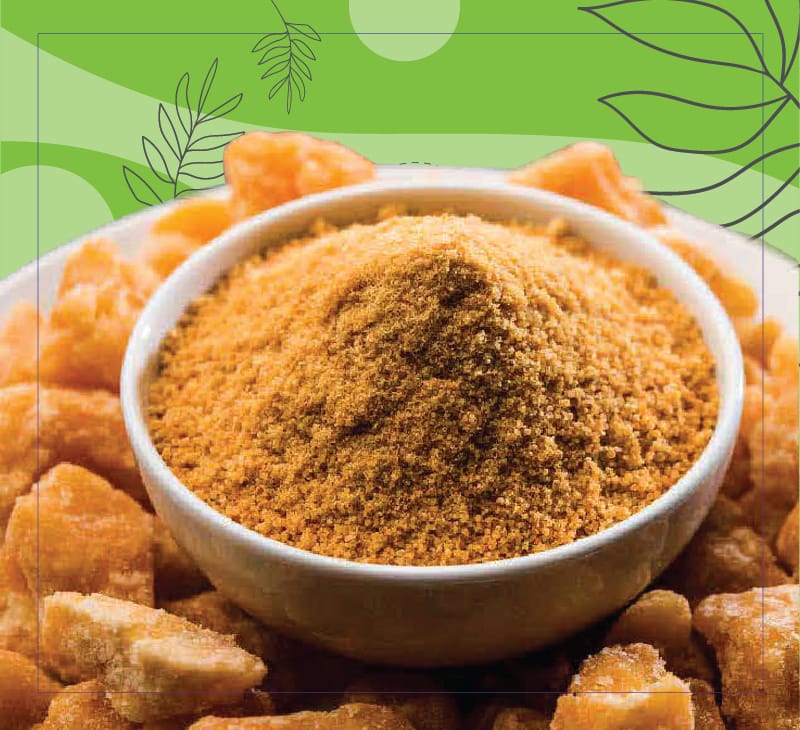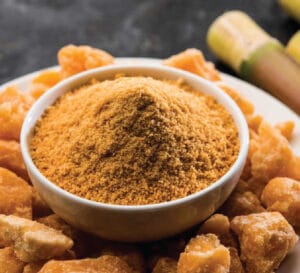
70% of the world’s jaggery (also known as non-centrifugal sugar) is produced in India. It is a type of sweetener which many people have replaced with sugar due to its nutritious content [2].
Not only that, it is an active ingredient in most Ayurvedic ‘Kaadas’ which keep immunity strong and protect from harmful diseases and viruses that are now emerging in the world.
Jaggery is a name that is influenced by the western world; in India and Ayurveda, it is called Gur/Gud. It is commonly made out of sugarcane while in other countries Gur is made from the date palm.
Undoubtedly, jaggery is more nutritious than sugar which is why it is highly recommended to consume it in winter. Jaggery in winter is like a therapy to the body, it maintains gut health, improves the digestive system, helps in keeping the body warm and most importantly it gives energy to the body.
What all Does Jaggery Contains?
Jaggery or Gur contains calories, sucrose, fructose, glucose, protein, fat, iron, magnesium and potassium. Apart from all of these, jaggery also contains some B vitamins and minerals, including calcium, zinc, phosphorus and copper.
In comparison with jaggery, the normal refined white sugar contains empty calories with no vitamins and minerals which is harmful to one’s health of the three Ayurvedic Doshas of the body [2].
What are the Benefits of Jaggery, Especially in Winter?

Here are the main benefits of jaggery [2]:
- Jaggery prevents anaemia
- Its main benefit is improving gut health
- It makes the immune system stronger
- It also helps in liver detoxification
- It helps to tame asthma and chest congestion [3]
- Jaggery can help women during periods by calming mood swings and regaining lost energy
- It helps to keep the body warm during winter
- Jaggery’s nutrient portents help in migraine
Jaggery is essential in the Indian diet. It can be consumed directly, with bread/roti or turned into sweets like such as Payasam, Obbattu (Holige), Hurakki Holige stuffing. In Ayurveda, jaggery is known as medicinal sugar. Indian culture has used jaggery in tonics to treat a variety of ailments.
It has a great shelf life. Also, the light golden colour jaggery is injurious to health and therefore one should consume jaggery which is darker in colour [1].
In winter, Gur is the main ingredient in Til Ke Laddoo, Gadchak and Gur Ki Patti. It is also consumed during meals for good digestion and immunity in winter.
Ayurveda has recommended jaggery as it is healthier than refined white sugar but as Ayurveda suggests to intake everything in the right quantity, jaggery should also be consumed in the right quantity. At the end of the day, even jaggery is a type of sweetener and is extracted from sugarcane.
By replacing sugar with jaggery, one can consume important minerals and other nutrients.
Conclusion
To consume jaggery is the right choice, especially in winter it should be consumed daily. With an abundance of nutrients, it keeps the human body intact and helps to fight diseases. It is absolutely replaceable with white sugar as normal sugar is just empty calories but jaggery comes with minerals, vitamins, iron, zinc, magnesium and more. Gur/jaggery helps to keep Pitta Dosha of the body at balance by maintaining the digestive system of the body.
This article is reviewed by Dr. Sunanda Ranade





















